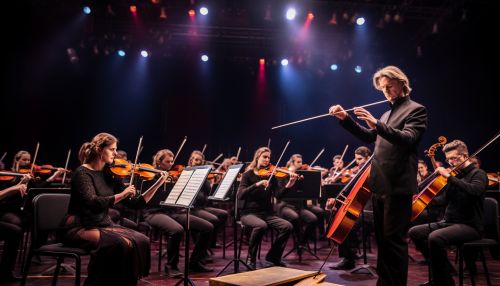Orchestra
History
The concept of an orchestra can be traced back to the ancient civilizations of Egypt and Greece, where ensembles of musicians would perform for religious ceremonies and royal events. The term "orchestra" itself originates from the Greek "orkhestra", a term used to describe the area in front of an ancient Greek stage reserved for the Greek chorus.
The modern orchestra evolved during the Renaissance and Baroque periods, with the development of new instruments and a growing understanding of acoustics and harmony. The orchestra as we know it today, however, did not truly take shape until the Classical period, with composers such as Wolfgang Amadeus Mozart and Joseph Haydn creating works specifically for this type of ensemble.
Structure
An orchestra is typically divided into four sections: strings, woodwinds, brass, and percussion. Each section is made up of different instruments that contribute to the overall sound of the orchestra.
Strings
The string section is the largest section of the orchestra and is typically made up of violins, violas, cellos, and double basses. The first violins often play the melody, while the other strings provide harmony and rhythm.
Woodwinds
The woodwind section consists of flutes, oboes, clarinets, and bassoons. These instruments are often used for their unique timbres and ability to play intricate melodies.
Brass
The brass section includes trumpets, French horns, trombones, and tubas. These instruments are known for their powerful and resonant sound.
Percussion
The percussion section can include a wide variety of instruments, from drums and cymbals to xylophones and marimbas. Percussion instruments are used to provide rhythm and to add color to the orchestra's sound.
Role of the Conductor
The conductor plays a crucial role in the orchestra, guiding the musicians through the music and shaping the performance. The conductor uses a baton and a series of gestures to communicate tempo, dynamics, and phrasing to the orchestra.
Types of Orchestras
There are several types of orchestras, each with its own unique characteristics and repertoire.
Symphony Orchestra
A symphony orchestra is a large ensemble that typically performs works from the classical music repertoire. These orchestras can include up to 100 musicians and often feature a full complement of strings, woodwinds, brass, and percussion.
Chamber Orchestra
A chamber orchestra is a smaller ensemble that typically performs works written for a smaller group of musicians. These orchestras usually have fewer than 50 musicians and often focus on music from the Baroque and Classical periods.
String Orchestra
A string orchestra is an ensemble made up entirely of string instruments. These orchestras often perform works written specifically for strings, as well as arrangements of works originally written for full orchestra.
Notable Orchestras
There are many notable orchestras around the world, each with its own unique sound and history. Some of the most renowned include the Berlin Philharmonic, the Vienna Philharmonic, the New York Philharmonic, and the London Symphony Orchestra.
See Also


